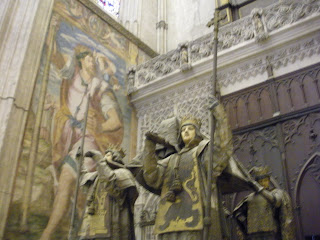
By way of introduction, I should mention that the city of Seville nowadays prefers to go by its Spanish name, Sevilla (pronounced “say-VEE-yuh”). As far as I can tell, the British modified the name some time ago to get around the confusing double L sound in Spanish and the change worked its way into the English lexicon utilized on the other side of the pond. If you recall the sometimes confusing debate over what to call the home of the 2006 Winter Olympics – Turi

n in English, and Torino in Italian – you’ll have a good sense of the problem. In any event, the difference is a small one and so I don’t think it too confusing to use Sevilla from this point forward.
Perhaps Seville’s greatest claim to fame rests with its former status as the peninsular link to the Spanish empire in the New World. During the sixteenth and seventeenth centuries, Sevilla held a monopoly on all trade with Spanish colonies, embracing everything from the yearly shipment of gold and silver from the mines of modern Mexico and Peru destined for the royal treasury in Madrid to a number of exotic commodities like sugar, coffee, tobacco, and chocolate. One of the more imposing structures in the city center, the Archivo General de Indias (General Archive of the Indies) serves as an imposing reminder of this legacy.
In the romanti

c era of the early to mid-nineteenth century, writers and artists cultivated an image of Spain as a timeless place in step with a folkloric portrayal of traditional Andalusian customs. It was during this time that Sevilla gained notoriety as the fictional home of the amorous adventurer Don Juan and the cigar-rolling temptress Carmen. During the middle of the twentieth century, Flamenco and bullfights became central to the international image of Spain and a useful way to draw tourists. When it comes to Flamenco and bullfights, Sevilla fits the bill quite well as the home of numerous tablaos (Flamenco bars) and the Plaza de Toros de La Real Maestranza, Spain’s premier bullfighting ring.
Sevillano culture and the sevillanos themselves posses a number of characteristics that are wholly their own. Andalusia – the southernmost region in Spain of which Sevilla is the capital – is generally known as a land of whitewashed buildings, but this practice is often accented by sevillanos with the addition of yellow paint to adorn important architectural features. A city known for its Holy Week festivities, Sevilla also maintains a popular religiosity that borders more on custom than piety.

My first week in my new place witnessed a procession one block over (picture at right).
There is also a distinctive sevillano accent, though I personally find it indecipherable from that of other Andalusian towns. Although sevillanos (and Andalusians generally) abide by the standard Castillian tendency toward lisped Cs before Es and Is, sevillanos prefer to drop the last letter of most words and omit Ds altogether in some cases. For instance, sevillanos pronou

nce the number 6 (seis) as “SAY-eh” and the word for state (estado) as “es-TAH-oh.” Needless to say, this can be very confusing; an S at the end of a word in Spanish, like English, denotes quantity and indiscriminately stripping letters from a word can change the meaning.
I plan to write more on Sevilla, my new home. As I mentioned in the previous post, I should be able to post updates more regularly now that I’m almost completely situated.

 nt and visible architectural monument. Along with the towers of the Plaza de España to south, it dominates the medieval four story skyline of the city center. Built atop the foundations of a former Islamic mosque dating to the twelfth century, construction on the bulk of the present Christian structure continued throughout the fifteenth century. Although much of the original mosque was demolished during this process, the minaret and courtyard, now the Cathedral’s bell tower and the Patio de los Naranjos, respectively, remained virtually intact. As a final testament to the ages, Roman columns fashioned by the city’s earliest inhabitants were placed in a continuous ring about the building.
nt and visible architectural monument. Along with the towers of the Plaza de España to south, it dominates the medieval four story skyline of the city center. Built atop the foundations of a former Islamic mosque dating to the twelfth century, construction on the bulk of the present Christian structure continued throughout the fifteenth century. Although much of the original mosque was demolished during this process, the minaret and courtyard, now the Cathedral’s bell tower and the Patio de los Naranjos, respectively, remained virtually intact. As a final testament to the ages, Roman columns fashioned by the city’s earliest inhabitants were placed in a continuous ring about the building.

 disinterred and taken to Havana in the late eighteenth century. After Spain lost Cuba to the United States in 1898, the remains were taken to Sevilla. The discovery of a casket bearing the name Cristobal Colón in Santo Domingo during the nineteenth century led some to believe that the actual body never made it off the island of Hispaniola. Although DNA testing appears to validate the remains in Sevilla, authorities in the Dominican Republic have never conceded to similar testing.
disinterred and taken to Havana in the late eighteenth century. After Spain lost Cuba to the United States in 1898, the remains were taken to Sevilla. The discovery of a casket bearing the name Cristobal Colón in Santo Domingo during the nineteenth century led some to believe that the actual body never made it off the island of Hispaniola. Although DNA testing appears to validate the remains in Sevilla, authorities in the Dominican Republic have never conceded to similar testing.










